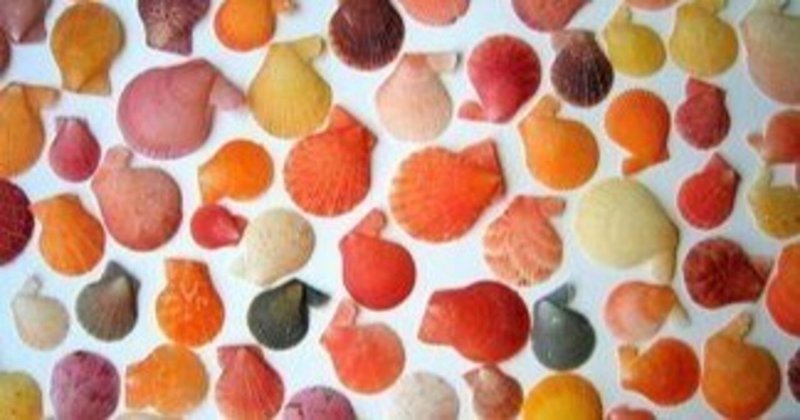
高校生だった頃の国語の教科書に載った福永武彦の随筆のこと
先に書いた通り、森鷗外の『舞姫』は、高校の国語の教科書で習ったのだけれど、それよりも印象に残っている随筆がある。
貝殻を集めるというのは、海岸に行った人なら誰しも覚えのあることで、特に学問または趣味として蒐集している人を別にすれば、子供っぽいと言われてもしかたがあるまい。しかし人は心の中に多少に拘らず子供の心を保存しているものだし、浜辺を逍遥しながら忘れていた子供の心を思い出して、つい足許から色の美しい貝殻を拾い取るというのは自然の情である。大の男でさえそういうことはあろうから、これを女子供の戯れとのみは言い切れまい。それは一つには、自然の産物として、貝殻は小さくて、手頃で、芸術的で、押花のように色があせることもなく、石のように重たくて持ち運びに不便だということもない。
この出だしの文章は、今読み返しても、文体にリズムがあって、好きだ。国語の授業の断片を思い出す。2年生の時だった。
東京オリンピックのあった年の十月の下旬、私は一人金沢から能登半島に遊んだ。初めての土地で、金沢は知人がいて案内してもらったが、能登の方はガイドブックを予めぱらぱらと見た程度である。しかしそれによって、能登金剛と呼ばれる福浦から富来に至る奇巌地帯は一見の価値があると判断した。それと共に、富来の海岸は砂浜が続いていて、そこは古来三十六歌仙貝の産地として名高いという解説も読んだ。これが私の好奇心を刺戟したので、私はローカル線の終点からバスに乗って福浦に行った。
1964年の東京オリンピックのことはよく知らない。その頃、まだ私の家にテレビは無かった。その当時の東京の賑わいもわからない。
この随筆の作者は、東京オリンピックに背を向けて、一人で能登半島を旅している。
その当時、福浦から富来までは遊覧船が運行されていたが、もう今はないようだ。彼はこの遊覧船のただ一人の客となって、30分ほど乗船して奇巌地帯を眺めたあと、富来に着く。ここで泊まる旅館は湖月館という名で、今でも続いている。
旅館に荷物を置いたあと、彼は、増穂の浦という浜辺に出て、貝殻を拾う。
見渡す限り、遠くまで砂地が続き、左には日本海が、波静かとはいいながら沖合には白く吠える波頭を見せ、右手には背の低い松林が砂丘の上に細長く続いている。そして足許を見ると、これが砂か貝か見分けがつかないほど、小さな貝殻で埋め尽されている。私は波打際に近いあたりを、時々腰を屈めて貝殻を拾いながら歩いて行ったが、立ち止れば必ず綺麗な貝殻が数限りなく眼につくのだから、殆ど一歩も進めない。
彼はハンカチに入るほどの貝殻を拾った後、旅館に帰る。翌朝、宿を出る時に、旅館の女将さんとお嫁さんが冬の間に集めた貝殻の入った袋をもらう。今でも、この旅館では泊り客にそういうサービスをし続けているという(タイトル写真は、湖月館のサイトから引用)。
貝あわせという遊びがある。物合せの一種で、珍しい貝を左右二組が互いに見せ合って優劣を争うみやびやかな競技である。(中略)
王朝の貴族たちの優雅な遊びに使うためには、姫君や女房の手に触れた貝の種類は、今ほど多くはなかったろうが、珍しいものを入手する点では遥かに困難だったろう。瑠璃の壺に入れて宝石のように大事にしていたに違いない。
この随筆は教科書に載らなければ、多分ずっと知らないままだったと思う。これを教科書に載せた人に感謝したい。作者の福永武彦は、日本文学史の中の存在になってしまった。今の教科書にも、このような優れた随筆は載っているのだろうか。
彼がここを訪れてから数年後、福浦からすぐ近くに原子力発電所を作る計画が持ち上がり、1993年から1号機が稼働開始した。
その後、活断層の活動による被災の危険性を指摘され、今は停止中だという。

増穂の浦のありさまは、彼が訪れた頃から変わっただろうか。
An essay written by Takehiko Fukunaga in a Japanese language textbook when I was a high school student.
As I wrote earlier, I learned Mori Ogai's "Maihime" in my high school Japanese language textbook, but there is an essay that left a stronger impression on me than that.
Collecting seashells is something that everyone who has been to the beach has done at some point in their lives, and it could be called childish, especially if you are not collecting them for study or as a hobby.
However, we all retain a child's spirit, whether it be a little or not, and it is natural for us to recall our forgotten childhood spirit as we flounder along the beach and pick up a beautifully colored shell from under our feet.
Even grown men may do this, so it cannot be said that this is a game for women and children.
For one thing, as a product of nature, shells are small, easy to hold, artistic, and do not fade in color like pressed flowers, nor are they heavy and inconvenient to carry like stones.
I like the sentence that starts out this way, even when I read it back now, because of the rhythm in the writing style. It reminds me of a fragment from my Japanese class, back in second grade.
In late October of the year of the Tokyo Olympics, I traveled alone from Kanazawa to the Noto Peninsula. It was my first time in Kanazawa, and although I had an acquaintance who guided me around, I had only skimmed through a guidebook on Noto beforehand.
However, I judged that the area of strange rocks from Fukuura to Tomirai, called "Noto Kongo," was worth seeing. I also read that the coast of Tomirai has a long sandy beach, which has been famous since ancient times as a place of production of the 36 poets' shells. This piqued my curiosity, so I took a bus from the end of the local line to Fukuura.
I don't know much about the 1964 Tokyo Olympics. At that time, there was no television in my house. I do not know how lively Tokyo was at that time.
The author of this essay traveled alone in the Noto Peninsula, with his back to the Tokyo Olympics. At that time, a sightseeing boat operated from Fukuura to Tomiki, but it does not seem to operate anymore.
He was the only passenger on the boat, and after a 30-minute ride to view the strange rock formations, he arrived at Tomiki. The inn where he stays is called Kogetsu-kan, and it is still in operation.
After leaving his luggage at the inn, he went out to a beach called Masuho no ura to pick up shells.
As far as the eye can see, the sand stretches far into the distance, and to the left is the Sea of Japan, while the waves are quiet, but offshore you can see the white crests of the waves, and to the right is a long, narrow grove of pine trees on top of the sand dunes.
And when you look at the sandy beach at your feet, it's filled with so many tiny shells that you can't tell whether it's sand or shells.
I walked along the edge of the beach, occasionally bending over to pick up shells, but every time I stopped, I could see countless beautiful shells, so I could barely take a step.
After picking up enough shells to fit in a handkerchief, he returns to the inn. The next morning, when he leaves the inn, he is given a bag of shells that the landlady of the inn and her son's wife have collected during the winter. Even now, the inn continues to provide such services to its guests (the title photo is taken from the Kogetsukan website).
There is a game called "kaiawase". A kind of matchmaking, it is a pompous competition in which two groups show rare shellfish to each other and compete for superiority. (Omitted)
In order for the nobles of the dynasty to play elegantly, the types of shells touched by princesses and court ladies would not have been as numerous as they are now, but it would have been much more difficult to obtain rare ones. They must have been placed in a lapis lazuli jar and treasured like a jewel.
If this essay had not appeared in textbooks, I probably would have remained unaware of it. I want to thank the person who put this in the textbook. The author, Takehiko Fukunaga, has become a presence in the history of Japanese literature. I wonder if there are such excellent essays in textbooks today.
A few years after he visited the Noto Peninsula, a plan to build a nuclear power plant very close to Fukuura was raised, and in 1993 Unit 1 began operation.
After that, it was pointed out that there was a danger of disaster due to the activity of the active fault, and it is currently suspended.
この記事が気に入ったらサポートをしてみませんか?
